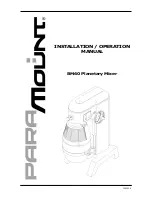
L/R Bus, Mix-B (Monitor),
tape, or from the external
inputs to be used individu-
ally or together in any
combination to drive the
respective outputs. An
additional switch shall cause
the control room/studio
outputs to operate as stereo
L/R or mono L+R. Outputs
from the control room and
studio section shall be via
unbalanced transformerless
1
/
4
" TS connectors in the
master output section. Input
to the 2-track return for the
control room and studio
section shall be via unbal-
anced transformerless 1/4"
TS connectors in the master
section, and shall be
designated 2-track input.
Input to the external input
for the control room and
studio section shall be via
unbalanced transformerless
1
/
4
" TS connectors in the
master section, and shall be
designated external input.
21. MASTER SECTION -
SOLO.
The audio mixer’s
master section shall include
a rotary level control to
govern the overall level of
the stereo-in-place solo
system. The rotary control
shall have a detent at top
dead center, which shall be
the Unity Gain calibration
point employed for proper
inline input/output channel
level checking in solo mode.
In addition, the solo level
control shall have an
operator’s stress reducing
device in the form of a big
rude flashing LED that
indicates solo system
operation, working in
conjunction with the indi-
vidual solo LED’s on each
panel or output subsection.
22. MASTER SECTION -
TALKBACK.
The audio
mixer’s master section shall
include a rotary level control
to govern the level of the
talkback system, with
unbalanced transformerless
1
/
4
" TS connectors in the
master output section,
designated Mix-B (Monitor)
Outputs L/R.
19. MASTER SECTION -
PHONES 1, PHONES 2.
The
audio mixer’s master section
shall include two headphone
systems, each with a rotary
level control to govern the
overall output level as
delivered to the respective
outputs in the master section
designated Phones 1 and
Phones 2. In addition, each
phones system shall include
selection switches that allow
signals from the control
room, Mix-B (Monitor), AUX
send 3(L) and 4(R), AUX
send 5(L) and 6(R), or from
the stereo external inputs to
be used individually or
together in any combination
to drive the phones output.
Note: Selecting Control Room
will override all other selec-
tions. Solo switching shall
provide stereo solo-in-place
auditioning of the overall
signal level on each of the
phone systems via the
control room/studio monitor
outputs. If control room is the
source for a phones circuit,
the solo function shall be
disabled. Output signals from
Phones 1 and Phones 2 shall
be via 1/4" stereo connector
(tip=left, ring=right).
20. MASTER SECTION -
CONTROL ROOM AND
STUDIO LEVEL (SPEAKERS).
The audio mixer’s master
section shall include two
rotary level controls to
govern the overall output
level as delivered to the
control room and studio
outputs, respectively. In
addition, the control room/
studio circuits shall provide
selection switches that
allow signals from the main
associated selection mo-
mentary switches that allow
signals to be sent from the
talkback to the Submaster
and MainL/R outputs; AUX
send 1; AUX send 2; to
Phones 1, Phones 2 and
Studio outputs, individually
or together in any combina-
tion. A microphone shall be
provided inside of the audio
mixer’s front panel in the
master section to drive the
talkback system.
23. MASTER SECTION - AUX
SENDS.
The audio mixer’s
master section shall include
six rotary level controls to set
overall signal levels delivered
to the AUX Send outputs for
AUX 1, AUX 2, AUX 3, AUX 4,
AUX 5, and AUX 6. Each AUX
Send shall have an associ-
ated solo switch to allow an
individual AUX Send to be
singled out of the mix and
auditioned alone or in
combination with any other
signals in the control room
and studio outputs. Addition-
ally, activating this solo shall
allow the AUX Send’s output
level to be observed on the
solo/main bargraph meters.
24. MASTER SECTION - AUX
RETURNS.
The audio mixer’s
master section shall include
six rotary level controls to set
overall signal levels returned
via the stereo AUX Returns
which shall be designated
AUX Return 1, AUX Return 2,
AUX Return 3, AUX Return 4,
AUX Return 5, and AUX
Return 6. Each AUX Return
shall have an associated solo
switch to allow an individual
AUX Return to be singled out
of the mix and auditioned
alone or in combination with
any other signals in the
control room and/or studio
outputs. Additionally,
activating the solo shall
allow the AUX Return’s
output level to be observed
on the solo/main bargraph
meters. Switchable assign-
ment routing switches
4
4























